1. Implement Automated Monitoring Tools
One of the most effective ways to automate server monitoring is by utilizing specialized monitoring tools. These tools can continuously track server performance metrics such as CPU usage, memory consumption, disk space, and network traffic. Popular tools include Prometheus, Zabbix, and Datadog. They provide real-time alerts and detailed reporting, which helps in identifying bottlenecks and potential failures before they affect your server's performance.
2. Set Up Alerts and Notifications
Automating server monitoring is not just about tracking data; it also involves timely communication of issues. Setting up alerts and notifications is crucial. Most monitoring tools allow you to configure alerts based on specific thresholds. For example, if CPU usage exceeds 85%, an automatic notification can be sent via email or SMS. This proactive approach ensures that you can address issues swiftly, minimizing downtime and enhancing server reliability.
3. Utilize Cloud-Based Monitoring Solutions
Cloud-based monitoring solutions offer scalability and flexibility that traditional on-premise tools may lack. Services like New Relic and Amazon CloudWatch provide comprehensive monitoring capabilities that can be easily integrated into your existing infrastructure. These platforms often feature user-friendly dashboards, enabling you to visualize performance metrics and trends over time, helping you to make informed decisions about your server management.
4. Automate Reporting Processes
Automated reporting is essential for ongoing server health assessments. By scheduling regular reports, you can keep track of performance metrics without manual intervention. Most monitoring tools can generate reports on a daily, weekly, or monthly basis, providing insights into trends and anomalies. This information can be invaluable for performance tuning and capacity planning. Automating these reports allows your team to focus on analysis rather than data collection.
5. Integrate with Other Systems
Integrating your monitoring system with other tools can significantly enhance your automation efforts. For example, integrating with incident management systems like PagerDuty or Opsgenie can streamline your incident response process. When an alert is triggered, these systems can automatically create tickets and assign them to the appropriate team members. Additionally, integrating with CI/CD pipelines can help automate deployment monitoring, ensuring that any new changes do not negatively impact server performance.
Conclusion
Automating server monitoring is essential for maintaining optimal performance and minimizing downtime. By implementing automated monitoring tools, setting up alerts, utilizing cloud-based solutions, automating reporting, and integrating with other systems, you can enhance your server management strategy. These practices not only improve efficiency but also contribute to a more reliable and robust infrastructure. Embrace automation to stay ahead in the competitive landscape and ensure that your servers run smoothly.
Summary Table
| Automation Method | Description |
|---|---|
| Automated Monitoring Tools | Use tools like Prometheus, Zabbix, and Datadog for real-time tracking. |
| Alerts and Notifications | Configure alerts based on performance thresholds for timely issue response. |
| Cloud-Based Solutions | Utilize services like New Relic and Amazon CloudWatch for scalability. |
| Automated Reporting | Schedule regular performance reports for ongoing assessments. |
| System Integration | Connect monitoring tools with incident management and CI/CD systems. |





